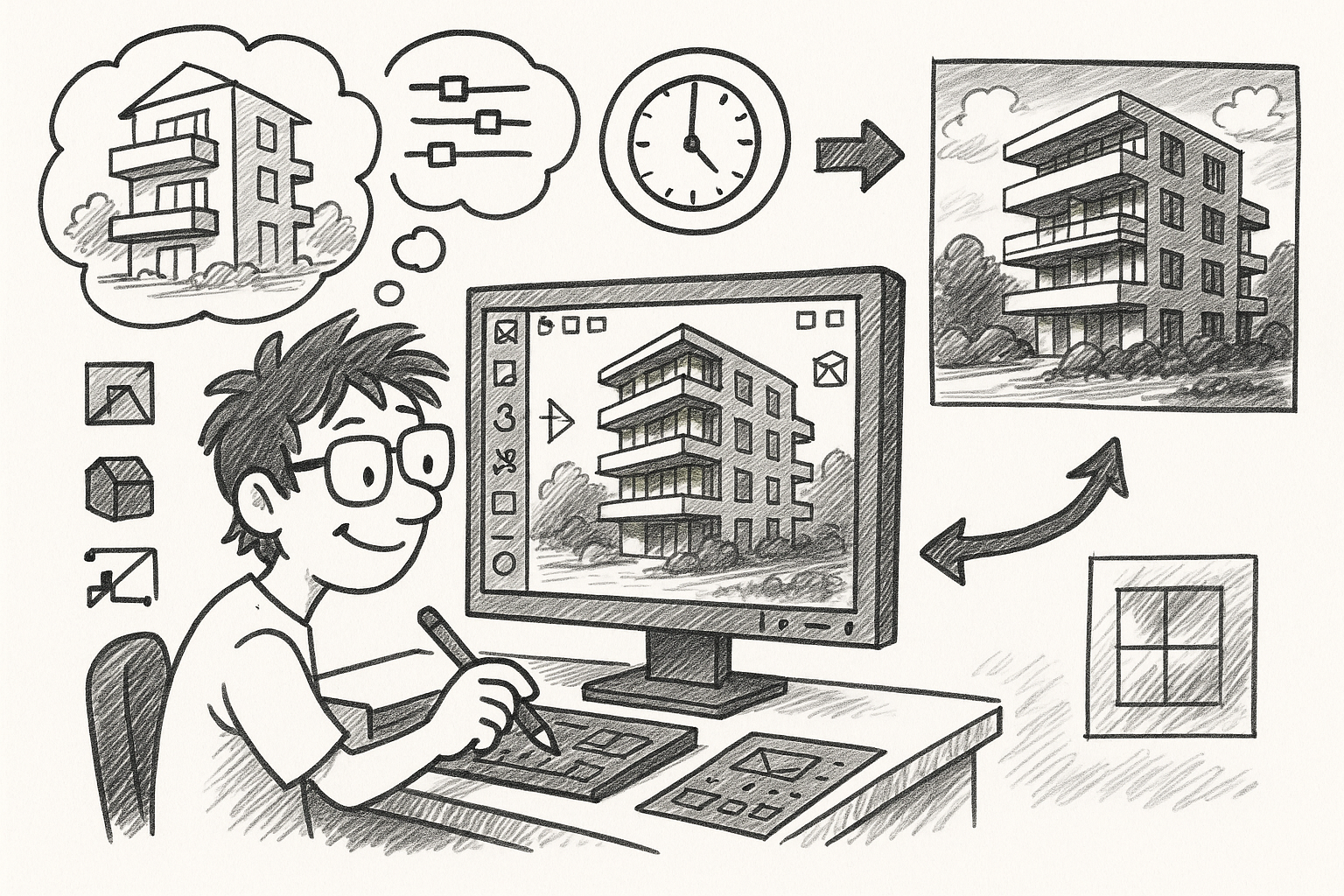Your Cart is Empty
Customer Testimonials
-
"Great customer service. The folks at Novedge were super helpful in navigating a somewhat complicated order including software upgrades and serial numbers in various stages of inactivity. They were friendly and helpful throughout the process.."
Ruben Ruckmark
"Quick & very helpful. We have been using Novedge for years and are very happy with their quick service when we need to make a purchase and excellent support resolving any issues."
Will Woodson
"Scott is the best. He reminds me about subscriptions dates, guides me in the correct direction for updates. He always responds promptly to me. He is literally the reason I continue to work with Novedge and will do so in the future."
Edward Mchugh
"Calvin Lok is “the man”. After my purchase of Sketchup 2021, he called me and provided step-by-step instructions to ease me through difficulties I was having with the setup of my new software."
Mike Borzage
Mastering Photorealistic Architectural Visualization: Key Features of Autodesk 3ds Max for Unmatched Realism and Efficiency
July 04, 2025 5 min read


Architectural visualization demands a level of photorealism that convinces clients, accelerates approvals, and differentiates design firms in an increasingly competitive marketplace. Autodesk 3ds Max remains a cornerstone because its feature set aligns perfectly with the physical principles of light, materiality, and camera optics that underlie persuasive imagery.
Physical Cameras & Exposure Controls
Digital visualization rises or falls with how closely the virtual camera behaves like the sensor of a real-world DSLR or a cinema rig. The Physical Camera in 3ds Max substitutes guesswork with measurable parameters—focal length, aperture, shutter speed, ISO, and white balance—ensuring the render pipeline starts on a foundation of optical truth. When an architect tweaks daylight openings, the exposure system translates those architectural decisions into realistic brightness values, preserving true contrast ratios between interior and exterior.
Depth of Field and Motion Blur are calculated from the same aperture and shutter data, so the soft-edge bokeh in a shallow-focus interior or the subtle streaks of passing traffic outside a glass façade feel organically tied to the scene. The Camera Correction modifier straightens verticals, eliminating the keystone distortion that plagues tight interior shots without compromising perspective.
- Virtual lens attributes such as bloom and vignetting add micro-level imperfections—light bleed, peripheral darkening—that the human eye subconsciously associates with authentic photography.
- Preset rigs for 35 mm stills, IMAX, and anamorphic cinematography allow studios to comply with marketing departments that specify exact framing requirements for brochures, social, or broadcast edits.
Because these settings feed directly into the Arnold exposure pipeline, lighting artists receive immediate, screen-accurate readings in the viewport. The result is a camera workflow that satisfies both the technical director who needs linear data and the creative director who judges aesthetics by eye.
Photometric Lighting & Sun/Sky System
Light is the narrative engine of any architectural visualization, guiding the viewer through volumes, textures, and spatial hierarchies. 3ds Max’s photometric toolkit speaks in the language of physics—lumens, candela, color temperature—rather than arbitrary intensity percentages. Dropping an IES profile into a fixture instantly replicates the real falloff curve provided by manufacturers, aligning concept renders with eventual on-site luminaires.
The Sun Positioner leverages geographic coordinates, altitude, azimuth, and time of year to simulate solar studies that satisfy LEED daylighting credits or local code requirements. Pair it with the Hosek–Wilkie sky model and you receive realistic turbidity, ozone thickness, and atmospheric scattering that echo regional climates from Nordic winter to equatorial noon.
Indirect illumination is just as critical. Brute-Force GI paired with Light Cache in Arnold calculates multiple bounces so a timber ceiling softly tints reflected light or a polished marble floor subtly brightens an atrium. LightMix and Light Explorer empower artists to re-balance luminaire groups interactively—warm up accent spots, dim sconces around a circulation path—without full re-renders.
Physical Material & PBR Workflow
Materials are the contract between geometry and light. The unified Physical Material in 3ds Max embraces both metal/roughness and specular/glossiness dialects, so migrating assets between gaming engines, VR experiences, and cinematic stills becomes frictionless. Every slot—normal, height, opacity, translucency—respects the Energy Conservation principle, ensuring that increasing reflectivity automatically diminishes diffuse response, a critical detail for metals and high-gloss paint.
Multilayer capabilities permit a clear-coat over a lacquered wood panel or a subtle fabric sheen on an acoustic wall covering. Under the hood, Open Shading Language (OSL) nodes provide procedural grain, noise, or weathering. An artist can drive patina buildup with curvature data, simulate finger smudges on stainless steel using an inverted roughness map, or randomize board orientation across a parquet floor with a single expression.
The payoff is twofold: memory usage remains lean because procedural textures supersede 8-K bitmaps, and the Arnold viewport IPR displays every tweak live, allowing tactile iteration on laptop-class hardware.
- Pre-built libraries for concrete, brick, glass, wood, metal, and fabric accelerate initial scene setup.
- Drag-and-drop usability means interns or junior artists maintain material consistency without steep learning curves, protecting brand-level aesthetics across high-volume deliverables.
Integrated Arnold Renderer & Real-Time IPR
Rendering is traditionally the most time-hungry stage in arch-viz. Arnold’s hybrid CPU/GPU architecture—leveraging Nvidia OptiX or Radeon ProRender where available—offers scalable horsepower without large on-premises farms. Adaptive sampling detects noisy regions (glossy caustics beneath a skylight, for example) and allocates extra rays there, easing fireflies while keeping clean areas efficient.
OptiX AI denoising reconstructs grainy passes by analyzing noise patterns in the color buffer, AOVs, and motion vectors. The upshot: clean 4-K hero frames in a fraction of the previous time budget, liberating hardware cycles for creative revisions rather than brute-force iteration.
Cryptomatte IDs embed object, material, and layer masks in exr output. Post-production houses pull these into Nuke or After Effects to relight, grade, or adjust saturation without re-rendering. A matte for glazing, mullions, and curtain wall spandrels, for instance, lets a marketing team try multiple brand colors during late-stage approvals.
Procedural Modeling & Scene Population Tools
Geometry acquisition from BIM is rarely viewer-ready; parametric modifier stacks convert sterile CAD imports into emotionally resonant scenes. An Array modifier can propagate mullions across a curtain wall while retaining control over division size and gasket thickness. Surface Noise lends organic waviness to poured-in-place concrete, catching specular highlights that sell scale.
Population tasks—landscape foliage, street furniture, human entourage—benefit from data-driven scattering. Arnold Procedurals, Forest Pack, or RailClone read CSV height maps, vegetation density layers, or GIS curve data, deploying thousands of instanced meshes without bloating scene memory. Nested instancing means a single birch tree asset serves hundreds of copies, each randomized by rotation, scale, or autumn leaf gradient.
When multiple design options coexist—shell iterations A, B, C or varying furniture sets—Scene States store visibility, material overrides, and lighting scenarios. Switching states swaps out a glass balustrade for a perforated metal one in seconds, preserving keyframe animation where necessary. Layers extend the concept by grouping décor, signage, and FF&E so that clutter shifts out of the viewport when the architect needs to focus on structural logic.
A direct link workflow with Revit or other BIM platforms watches for updated DWGs. When a project architect moves a load-bearing column 200 mm, the modifiers stay live; façade arrays realign, instanced mullions retarget, and lighting studies remain valid without manual rebuilds. The cycle time from CAD change to final render shrinks dramatically.
Collectively, these capabilities form an integrated ecosystem inside 3ds Max. The Physical Camera guarantees optical plausibility; the photometric engine paints daylight and artificial light with scientific accuracy; material workflows translate surface science into artistry; Arnold’s interactive path tracing offers instant validation; and procedural modeling scaffolds creativity while maintaining efficiency. Harnessed together, they empower architectural visualization teams to deliver **convincingly photorealistic** imagery on compressed schedules—securing approvals, winning competitions, and elevating brand perception.
Whether you are refining a luxury residential shot at golden hour or orchestrating a parametric daylight study for a sprawling airport terminal, deploying these tools in concert ensures your renders not only look stunning but also stand up to the scrutiny of measurable reality.
Also in Design News

Revolutionizing Design Workflows: The Power of Cloud-Based Repositories
July 04, 2025 8 min read
Read MoreSubscribe
Sign up to get the latest on sales, new releases and more …




